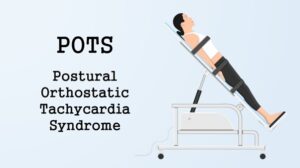POTS, which stands for Postural Orthostatic Tachycardia Syndrome, is a medical condition involving an issue with the autonomic nervous system (ANS). The ANS is involved in regulating automatic physiological processes such as heart rate, blood pressure, breathing, and digestion.
This system helps control your heart rate and blood pressure to make sure blood flows where it’s needed. When you stand up, this system quickly adjusts to keep blood flowing to your brain and other important organs despite the change in posture.
But in people with POTS, this system doesn’t work quite right. When they stand up, their heart rate goes up a lot faster than it should. This can make them feel dizzy, lightheaded, or even faint. It’s like their body overreacts to the simple act of standing up.
POTS can be a bit like an internal traffic jam. The blood doesn’t flow as smoothly as it should, and this can cause a bunch of symptoms like racing heart, fatigue, and sometimes even brain fog. It’s important for people with POTS to work with their doctors to find ways to manage these symptoms and improve their quality of life.
Diagnostic Process
Due to the individual nature of the condition, POTS can be diagnosed in a variety of ways with two of the main criteria including:
- Chronic, day-to-day symptoms of orthostatic (postural) intolerance
- Rise in heart rate of >30 bpm after 10 minutes of standing without hypotension, with symptoms (>40bpm in children)
This can be measured using a tilt table as pictured above or by going from lying to standing and measuring blood pressure and heart rate after waiting 10 minutes.
Causes of POTS
The exact cause of POTS is not always clear, and it can be multifactorial, with a combination of genetic, environmental, and physiological factors. Here are some of the potential contributing factors:
- Autonomic Dysfunction
- Genetics
- Autoimmune Factors
- Viral Infections
- Deconditioning
- Blood Volume and Pooling
- Hormonal Changes
- Trauma or Surgery
- Joint Hypermobility and Connective Tissue Disorders
- Environmental Factors
Symptoms
- Fatigue, both physical and mental
- Headaches and migraines
- Light-headedness/dizziness/’seeing stars’
- Heart palpitations/tachycardia
- Exercise intolerance
- Post exertional malaise (PEM)*
- Sweating
- Nausea/low appetite/high thirst/salt cravings
- Low concentration/’brain fog’
- Irritability/anxious feelings/pronounced stress response
- Shakiness
- Sleep disturbances
- Chest pain
- Whole body pain
- Shortness of breath
- Blood pooling: swelling, reddish-purple mottling in legs
Benefits of Exercise for POTS
- Improved Cardiovascular Fitness: Regular exercise can enhance cardiovascular fitness, which can help improve the overall heart rate response and blood pressure control in individuals with POTS. This can reduce the severity of symptoms when transitioning from lying down to sitting, or from sitting to standing up.
- Enhanced Blood Volume: Exercise can help increase blood volume and improve blood vessel elasticity, both of which can be beneficial for POTS patients. Increased blood volume can help prevent excessive pooling of blood in the lower extremities upon standing.
- Autonomic Nervous System Regulation: POTS is associated with dysregulation of the autonomic nervous system. Exercise can potentially help retrain the autonomic nervous system, improving its ability to control heart rate and blood pressure in response to changes in posture.
- Strength and Endurance: Strengthening exercises can improve muscle tone, which can assist in reducing symptoms of POTS. Building muscle strength, especially in the legs, can aid in maintaining posture and preventing blood pooling.
- Psychological Benefits: Exercise can have positive psychological effects, including reducing anxiety and depression. Managing the emotional aspects of POTS can help individuals cope better with their symptoms.
It’s essential to approach exercise for POTS cautiously and gradually, as overexertion can worsen symptoms. It’s best to work with a healthcare professional, preferably one versed in managing POTS, to develop a personalized exercise plan tailored to your specific needs and limitations. This plan might include aerobic exercise, strength training, and flexibility exercises, all performed at a pace and intensity that suits your condition.
Start slowly and listen to your body. Pay attention to how your symptoms respond to different types of exercise. For some, recumbent exercises (those performed in a reclined position) might be more suitable, while others may tolerate upright exercises as they progress.
In summary, exercise can be a valuable component of managing POTS by improving cardiovascular fitness, blood volume, and autonomic nervous system regulation. However, it should be part of a comprehensive treatment plan and tailored to an individual’s specific needs and limitations. If you are dealing with POTS and would like advice on what exercise program may be best for you, an Accredited Exercise Physiologist may be able to help you get on establish an effective, suitable plan.




